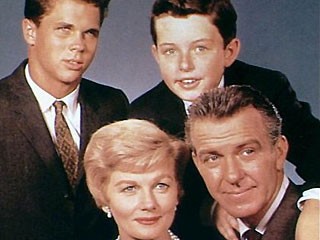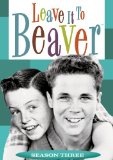| Reviews & Columns |
|
Reviews DVD TV on DVD Blu-ray 4K UHD International DVDs In Theaters Reviews by Studio Video Games Features Collector Series DVDs Easter Egg Database Interviews DVD Talk Radio Feature Articles Columns Anime Talk DVD Savant Horror DVDs The M.O.D. Squad Art House HD Talk Silent DVD
|
DVD Talk Forum |
|
|
| Resources |
|
DVD Price Search Customer Service #'s RCE Info Links |
|
Columns
|
|
|
Leave it to Beaver - Season Three
Shout! Factory's Season Three release gives those happy with the earlier Universal releases the option to continue buying the series season-by-season, while those who'd rather get the whole shebang at once can opt for the Complete Series route.
Personally, I'd argue Shout!'s Complete Series set is the way to go. It's a bit more expensive than buying the remaining seasons separately, but the packaging is handier, uniform, and most importantly the Shout! Factory discs for seasons 1 and 2 consist of six single-sided, dual-layered discs for each season as opposed to Universal's consistently terrible DVD-18s. You also get a disc of exclusive extra features.
(Note: This review incorporates text from the reviewer's review of Leave It to Beaver - The Complete Series. See that review for a more complete look at the series.)
Though perennially popular, Leave It to Beaver is one of television's most misunderstood, most under-appreciated comedies. For the past 50 years, it's been regarded with a strange, simultaneous mixture of fondness and derision. It became emblematic of '50s blandness and conservative family values, and accused of unrealistically presenting an idealized nuclear family, one whose matriarchal figure, for instance, did the vacuuming wearing a pearl necklace and high heels.
And yet as criticized as it was, it's always somewhere on the airwaves, even after television stations stopped showing old black & white TV shows and movies to make way for all those mind-numbing infomercials. Beaver somehow never lost its audience and it remained popular. But the shared affection toward Leave It to Beaver differs from other familiar, forever-syndicated programs like The Brady Bunch, a series remembered more because it was drummed into the collective consciousnesses of the '70s generation through endless UHF repeats rather than because it was any good. No, Leave It to Beaver is remembered because was an extremely well made, memorable show. As writer-producer Brian Levant remarks in one of the featurettes included with The Complete Series, Leave It to Beaver was almost unique among American sitcoms - it was wise.
While The Dick Van Dyke Show, about the home and work life of a comedy-variety television show writer, and Beaver, about two brothers and their relationship with their suburban middle-class parents, their friends and community, have entirely different agendas, they took the same basic approach. Their scripts slightly expanded into comic terms real-life incidents, authentic little slices of life that, in Beaver's case, captured the essence of youth.
As hardly needs explaining, Leave It to Beaver is a half-hour situation comedy focusing on the boyhood (and, later, the tumultuous teenage) trials and tribulations of Theodore "Beaver" Cleaver (Jerry Mathers) and his older brother Wally (Tony Dow), who live in a pleasant, middle-class suburban home with their parents, Ward (Hugh Beaumont) and June (top-billed Barbara Billingsley).
Created by Joe Connelly and Bob Mosher, who before this were writers on The Amos 'n Andy Show and who later wrote and produced The Munsters, Leave It to Beaver was ingeniously simple. Instead of a family sitcom told from a neutral, third-person perspective or which functioned mainly as a vehicle for its adult star, Leave It to Beaver told its stories entirely from Beaver and/or Wally's perspective - there are no shows pivoting around Ward and/or June's concerns. Indeed, the audience never even sees their bedroom during the entire run of the show.
The problems and challenges Beaver and Wally face might seem trivial or inane to adults, but Connelly and Mosher obviously remembered how monumentally important they could be to children and teenagers. One entire episode revolves around Beaver's stubborn determination not to dress-up for an awards banquet, another around Beaver's regret and embarrassment after he makes a funny face for a class picture. In another show Wally baby-sits Beaver who accidentally lets the bathtub overflow, which in turn seriously damages the plaster ceiling in the kitchen below. They successfully hide the disaster, but then Wally feels horribly guilty after Ward praises him for having been so responsible.
Ward and June are sweetly sensitive and understanding, but not really idealized. Ward is often (mildly) irritable while June tends to be fussy and overly protective of her children. Sometimes, they also - gasp! - actually make mistakes that create major problems for the boys. The idea of parents who don't have all the answers, who occasionally make mistakes, admit them and even apologize to their children isn't just unusual, but downright revolutionary in 1950s terms.
The casting is perfect. Mathers had been a naturally funny child star for a few years, most famously in Alfred Hitchcock's The Trouble with Harry (1955), and his characterization, awkward and naïve but kind-hearted, has real verisimilitude. Not surprisingly, cast members recall Mathers's amazing ability as a child performer, that he had a knack for nailing dialogue perfectly, usually on a first take, always coming off like a little boy speaking extemporaneously, never a child actor reading lines written by adults.
Tony Dow was less naturally talented but in some ways is even more believable as the somewhat more responsible eldest son. Both Hugh Beaumont and Barbara Billingsley had unremarkable careers before this. Billingsley had uncredited bit roles in major movies going back to 1945 and small roles in B-movies like Invaders from Mars (1953), while Beaumont, who also later became one of Beaver's regular directors, similarly bounced between bits in big movies and larger roles in small ones, including a stint as Michael Shayne.* Beaumont gives an especially amusing performance throughout the series, subtly revealing an acerbic sense of humor.
Probably the one character everyone remembers from Leave It to Beaver is Wally's rakish pal Eddie Haskell (Ken Osmond), whose slippery veneer of politeness cannot mask his wise-guy ways. The character and Osmond's amusing performance are priceless.
Eddie Haskell wasn't the show's only villain. Despite a reputation for idealizing '50s Americana, Leave It to Beaver was crowded with devious, self-involved, gluttonous, and destructive children and teenagers worthy of Roald Dahl. Wally and Eddie's pal Clarence "Lumpy" Rutherford (Frank Bank) was a fat, dumb, reformed bully and, if anything, Beaver's pals were even worse: among them the genuinely irritating Gilbert Bates (Stephen Talbot, whose very voice is like fingernails on a blackboard) and contemptible Larry Mondello (Rusty Stevens), who was always talking Beaver into things he wanted, and against the Beav's better judgment.**
Their parents were also anti-role models. Larry's mother (Madge Blake) spoiled and indulged her boy, as did Lumpy's father, pompous Fred Rutherford (Richard Deacon, in a role he virtually reprised as Mel Cooley on Carl Reiner's Dick Van Dyke Show).
Season Three has its share of memorable episodes: In the previously mentioned "Beaver Takes a Bath," the boys are home alone and Beaver ruins the kitchen ceiling when he forgets to turn the taps off upstairs; "Beaver's Prize" has a wonderful wrap-up to Beaver's conflict after secretly winning a bike at a matinee at a time when he was supposed to be at home, grounded. Indeed, just about every episode is a winner in a series that really never lost its touch.
Guest stars this season include Beverly Washburn, Madge Blake, Sue Randall, Ann Doran, Madge Kennedy, Jean Vander Pyl, Richard Deacon, Frank Albertson, Ross Elliott, Wendell Holmes, Norman Leavitt, Veronica Cartwright, Majel Barrett, and Ann Jillian. Most shows were directed by Norman Tokar, with most of the others by David Butler, Norman Abbott, and Hugh Beaumont. Creators Joe Connelly and Bob Mosher wrote or co-wrote most episodes.
Video & Audio
Leave It to Beaver - Season Three looks great, on par with the best CBS/Paramount releases of classic late-1950s/early-'60s titles (Perry Mason, Twilight Zone, etc.). The black and white, full-frame image is bright and impressively sharp, and the episodes appear uncut and unaltered. The 39 half-hour episodes are presented over six single-sided DVDs. Obscuring the first disc in each season case, an 11-page booklet offers a decent episode guide, with title, writer, director, original airdate, and a brief description of each show.
The original mono English is crisp and clear; English closed-captioning is offered.
Extra Features
Each season set includes an episode of Shokus Internet Radio's Stu's Show, an audio-only extra that plays over one or several episodes. This one features Frank Bank and Jerry Mathers and is a lot of fun.
Parting Thoughts
Though I'd recommend purchasing Leave It to Beaver - The Complete Series even if you already have the two Universal season sets, Season Three is another option for fans, particularly those with tight budgets wanting to spread out the expense of the these DVDs. The good news is that because the series expresses universal concerns of children and teenagers, it's as fresh today as it was 53 years ago when it premiered. Sentimental in the good sense, very fun, touching and - yes - often very wise, Leave It to Beaver is a must for fans and their children. I can't wait to show these to mine. Highly Recommended.
* Beaumont's attitude toward these low-budget films is revealed in a blooper inexplicably left in the movie Lost Continent (1951), in a scene where a group of scientists and explorers are pulling themselves up the side of a perilous plateau. As Beaumont watches star Cesar Romero grab one of the explorers by the butt to pull him over a cliff edge Beaumont, in the background, gets the giggles and has to turn away from the camera. Obviously, he didn't take any of this too seriously.
** Among some friends we even called this behavior "pulling a Mondello."
Stuart Galbraith IV's latest audio commentary, for AnimEigo's Musashi Miyamoto DVD boxed set, is on sale now.
|
| Popular Reviews |
| Sponsored Links |
|
|
| Sponsored Links |
|
|
| Release List | Reviews | Shop | Newsletter | Forum | DVD Giveaways | Blu-Ray | Advertise |
|
Copyright 2024 DVDTalk.com All Rights Reserved. Legal Info, Privacy Policy, Terms of Use,
Manage Preferences,
Your Privacy Choices | |||||||















